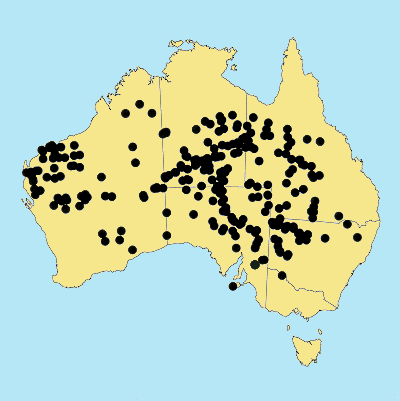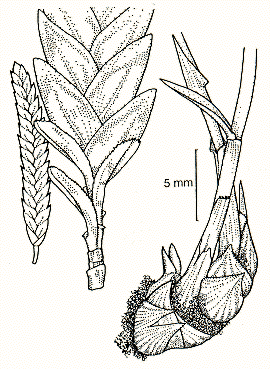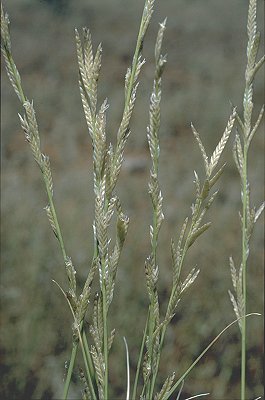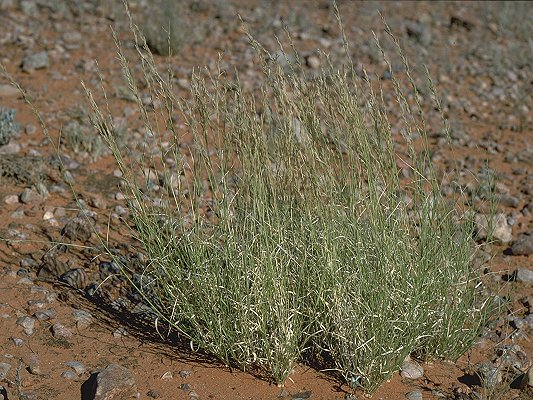Eragrostis xerophila Domin. J.
Linn. Soc., Bot. 41: 281 (1912).
Classification. (GPWG 2001) : Subfamily
Chloridoideae. Cynodonteae.
Type of Basionym or
Protologue Information: North W. Australia: inter fl. Ashburten et De Gray,
E. Clement s.n..
Key references
(books and floras): [1952] C.A.Gardner, Flora of Western Australia 1
Gramineae (124), [1981] M.Lazarides in J.Jessop (ed)., Flora of
Central Australia (458), [2002] D.Sharp & B.K.Simon, AusGrass,
Grasses of Australia, [2006] J.Jessop, G.R.M.Dashorst, F.M.James, Grasses
of South Australia (384), [2008] S.W.L.Jacobs, R.D.B.Walley &
D.J.B.Wheeler, Grasses of New South Wales (258).
Illustrations:
[1952] C.A.Gardner, Flora of Western Australia 1 Gramineae (123,
Pl. 35), [2005] K.Mallet (ed.), Flora of Australia 44B: Poaceae 3
(Fig. 65E-G), [2006] J.Jessop, G.R.M.Dashorst, F.M.James, Grasses of South
Australia (383, fig. 318), [2008]
S.W.L.Jacobs, R.D.B.Whalley & D.J.B.Wheeler, Grasses of New South Wales,
4th edn (258).
Habit.
Perennial. Rhizomes present, elongated. Culms erect, 16–50 cm tall, 10–20
-noded. Ligule a fringe of hairs, 0.5–0.6 mm long. Leaf-blades straight or
curved or curled or flexuous, flat or conduplicate or convolute, 2–8 cm long,
0.5–4.5 mm wide.
Inflorescence.
Inflorescence compound, a panicle. Panicle linear, 5–10 cm long, 0.6 cm wide,
contracted about primary branches.
Spikelets.
Spikelets pedicelled. Fertile spikelets many flowered, with at least 2 fertile
florets (8–76), comprising 8–76 fertile floret(s), with diminished florets at
the apex, linear or lanceolate or oblong, laterally compressed, 5–35 mm long.
Glumes. Glumes
similar. Lower glume ovate, membranous, without keels or keeled, 1-keeled, 1
-nerved. Upper glume ovate, membranous, without keels or keeled, 1-keeled, 1
-nerved.
Florets.
Fertile lemma 1.5–2.5 mm long, keeled, 3 -nerved. Lemma apex muticous or
mucronate. Lodicules present. Anthers 3.
Continental
Distribution: Australasia.
Australian
Distribution: Western Australia, Northern Territory, South Australia,
Queensland, New South Wales.
Western Australia:
Giles, Fortescue, Ashburton, Carnarvon. Northern Territory: Barkly
Tableland, Central Australia North, Central Australia South. South Australia:
North-western, Lake Eyre, Gairdner-Torrens Basin, Flinders Ranges, Eastern,
Eyre Peninsula, Murray. Queensland: Burke, South Kennedy, Gregory North,
Gregory South, Mitchell, Warrego. New South Wales: North Far Western
Plains.
Notes.
A useful fodder species in native pasture, drought-hardy and resistent to heavy
stocking.
Eragrostis xerophila intergrades with E.
setifolia, producing plants which resemble the latter species in panicle
structure, habit, foliage and caryopsis shape.
Distinguishing characters of typical E.
xerophila include rootbase rhizomatous, woolly or pubescent; culms wiry,
many-noded, scabrous, covered by overlapping leaf sheaths; leaf blades
coriaceous, flat and recurved, rigid, firmly pointed, curly with age; panicle
spiciform; florets finally loose; rachilla persistent, straight; glumes
nerveless, rounded on the back; lemmas membranous with hyaline margins, the
lateral nerves c. midway and often green and short; palea long, usually persistent,
3-lobed, with narrow flaps; anthers large, yellow or purple; caryopsis terete
or subterete, subacute, shiny, stipitate.
Endemic; widespread across Australia but not occuring
in Vic. Commonly in well-watered, grey, red or brown, heavy clays or clayey loams
on alluvial floodplains, grassland plains, stony tablelands, claypans, dune
swales, and depressions; also in saline, lateritic, and sandy loam soils.;
flowers all year round.; fruits all year round
